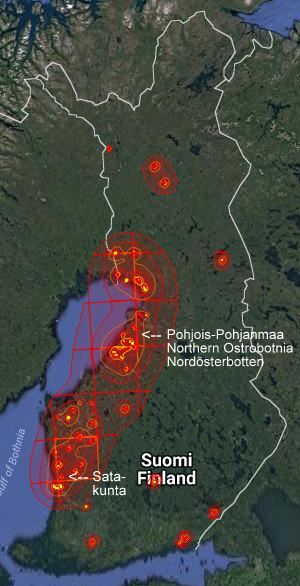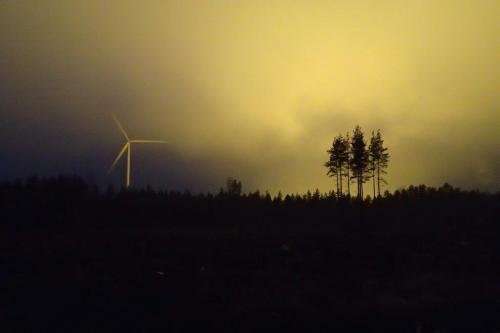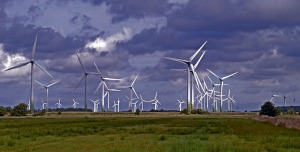The wind turbine infrasound causes harmful health effects as far as about 15-20 kilometers from wind turbines, according to the study conducted in Finland in 2016. The results of the pilot study are statistically significant. The risk distance depends on the circumstances: it grows if the height, amount or efficiency of the wind turbines increases or in a long-term exposure. The study confirms the results of the long-term study of Ceranna and Pilger (2004-2016) in Germany.
In Finland a pilot study (Mehtätalo et al. 2019) was conducted on the effects of wind turbine infrasound on the health of the people in the surroundings of wind turbines in 2016. The material of the study was collected in two regions, in Satakunta and Northern Ostrobotnia, (see Figure) in spring 2016. The study was sampled from two different registers by simple random sampling.
An interview method was used as a method for collecting research material. A total of 193 people from 46 families participated in the survey from areas where the wind turbines had been built and started 0.5–3 years before the interview. The distance of each family to the nearest wind turbine(s) as well as the building and starting time of the wind turbine(s) were found out for the interview. Some of the interviewees lived near wind turbines, some at a distance of tens of kilometers.
As the statistical method of the study was used the linear mixed model to test the statistical significance of the research material. The symptoms of the people were explained either by the direct distance (km) to the nearest wind turbine or by the exposure zone of the map model. Other explanatory variables included the register used, the gender and age of the person and his or her awareness in advance of potential harmful health effects from wind turbines.

The distance less than 15 kilometers from wind turbines was divided in four distance classes. The differences in answers between them were small and varied clearly only in the next class where the distance to the nearest wind turbine was more than 15 kilometers. The harmful or severe symptoms were clearly more common less than or about 15 kilometers from wind turbines than further away.
In addition to that, a map model was developed to describe the exposure zones, in other words the propagation, continuity and magnitude of the wind turbine infrasound, on a map of Finland (see Figure). The map model included three different exposure zones. In the first zone nearest wind turbines there was quite strong infrasound in all wind directions. In the second zone there was wind turbine infrasound often, due to the wind directions. In the third zone there was almost no wind turbine infrasound according to the computational model. The map model explained symptoms better than the direct distance to the nearest wind turbine.
Figure. The map model of the propagation of wind turbine infrasound in Finland in 2016. The material of the study was collected in the regions Satakunta and Northern Ostrobotnia.
There was no significant p-value for the damage increasing directly according to the distance (km) in the statistical analysis. The significant p-value was reached for the damage according to the map model describing the total exposure. In addition to that, symptoms were explained by person’s gender and age. Other background variables did not explain the symptoms statistically significantly.
The most typical symptoms were sleep disturbance or change in the need for night’s sleep, fatigue and various pains.
The results of the study show that there were remarkably more harmful health effects caused by the wind turbine infrasound in the exposure zones 1–2 of the map model than further away. The most important result of this study is that the risk distance grows if the height, amount or efficiency of the wind turbines increases or with time in a long-term exposure. This means that the risk distance depends on the circumstances. In the areas with wind turbines around the residential area there were harmful health effects as far as about 15–20 kilometers from wind turbines under the circumstances when this pilot study was conducted.
Thus, the potential damage should be investigated within a sufficiently long radius of the wind turbines, taking into account all wind turbines in the vicinity as well as the most typical wind directions. This study confirms the results of the long-term study of Ceranna and Pilger (2004–2016) about the propagation of the wind turbine infrasound in Germany. – syte/p
Ceranna, L. & Pilger, C. (2016). Der unhörbare Schall von Windkraftanlagen. Bundesanstalt für Geowissenschaften und Rohstoffe (BGR). https://www.bgr.bund.de/DE/Themen/Erdbeben-Gefaehrdungsanalysen/Seismologie/Kernwaffenteststopp/Projekte/abgeschlossen/hufe_wka.html



 Honkajoen tuulivoima-aluetta kuvattuna
Honkajoen tuulivoima-aluetta kuvattuna
 It has been found out in an American
It has been found out in an American 


 The
The